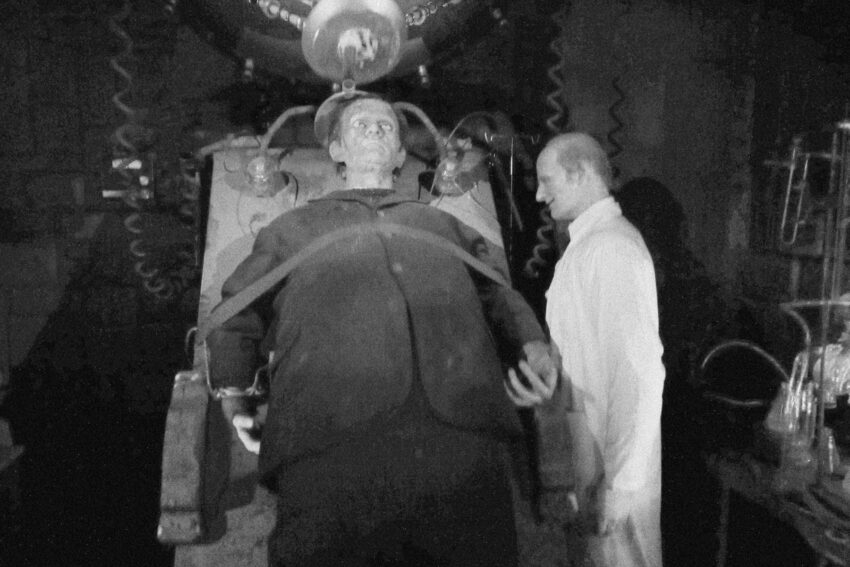Monsters are cool. They come from nightmares, so they have power over us that we don’t understand, and as transgressors who get away with whatever, they hold our attention. They’re cool.
They’re often the subject of scary stories. Not always, though. They’re useful in a lot of sorts of stories.
Monster Theory came out of that fascination. Everything’s got to have a theory. A lot of theories are dull. (String Theory? Who needs to know theories about strings?) Monsters, though…hard to mess up what’s cool about that.
Author Jeffrey Jerome Cohen—dean of humanities at Arizona State University—attacked this subject and developed Seven Theses of Monster Culture.
And they’re useful! Useful for telling scary stories, but useful for any story featuring any even vaguely transgressive character. So any story.
Read on and learn about Jeffrey Jerome Cohen’s identification of the Seven Theses of Monster Culture, a profound feature of the emerging field of Monster Theory.
So I took a class on this. If you want to read more into this, I recommend it. A lot of ink has been spilled on the subject of Monster Theory. It’s worth the research.
The following is a brief summary of the theses put forward by Jeffrey Jerome Cohen in his essay “Monster Culture (Seven Theses).” It has been published in a variety of places, I believe, but I read it in a book called Monsters, a collection of essays edited by Brandy Ball Blake and L. Andrew Cooper (available for purchase here, but also in used book markets). It’s a worthwhile book if you’re interested in this subject. Full of essays on a lot of monster theorists.
Without due further allotted, Seven Theses of Monster Culture.
1. The Monster’s Body is a Cultural Body
The look of the monster can make or break a story, you know? Like, we spend a bunch of energy thinking about how to make a monster look scary. People who do that for a living, they’ll spend every ounce of their skills using their understanding of human psyche to make a visual representation of fear.
Which creates an interesting question when we see versions throughout history of, for example, the same monster. The earliest examples of a monster might not scare us today.
That’s because what scared people once-upon-a-time reflected that once-upon-a-time. The scary tricks worked when they worked because of something in the collective psyche at that moment.
A great example of this is imagery of Dracula throughout the decades. Every generation rethinks Dracula and gives him a body that reflects their values.
2. The Monster Always Escapes
Transgression is about evolution. Rules have to exist, but they have to be tested. Monsters get to test rules, and we need them to test rules. Push against them.
If the monster gets killed, though, and I mean completely killed beyond all possible return, then the rules win.
We have a fundamental aversion to accepting that. The human psyche seems to shy at the thought of the rules winning outright.
A great example of this is the constant landslide of sequels and remakes we deal with every year. We know that the monster always escapes so they can always come back.
3. The Monster is the Harbinger of Category Crisis
“Category crisis,” first of all, is what happens when we look at stuff and can’t fit it into boxes. There are a lot of examples of that in the world right now.
Monsters function outside boxes. That’s part of why they’re fascinating and/or scary. We can’t classify them, so we try to figure them out.
So they spring out of our fear and fascination with encountering what we can’t fit into our normative understanding of reality.
Monsters come out of liminal spaces, and they help us to make a critical examination of those spaces.
Have you seen the film Ex Machina? It takes place in the “not-too-distant future,” and it’s about a computer/robotics genius who builds the most advanced chat bot of all time and houses it in the body of a robot that’s also a very pretty woman. It comes out that this “chat bot” is more complicated than that, and the story is built on a lot of cracks in what we think of as reality. Is she a woman? Is she self-aware? Is she a person? What is a person at all? What is self-awareness? What does it mean to be the bad guy? Really fascinating movie that’s built entirely on forcing an examination of broken stereotypes.
4. The Monster Dwells at the Gates of Difference
By a similar token as theory three, monsters will also help us to cope with exploring liminality. We are curious what’s past the monster, so we defeat the monster, so we can come to terms with the liminality it comes out of.
The attempt to cope with the monster is an attempt to reconcile the liminality behind them.
A great example of this is the alien in the Alien franchise. In a time when we are only barely beginning to sort of be able to look at other planets, there’s not much that’s more different than us than life outside of Earth’s atmosphere. It’s an open question whether we could even interpret it as life, let alone figure out its motivations. The Alien franchise stands and falls on its mystery.
5. The Monster Polices the Borders of the Possible
By nature, we are explorers. Not sure why–that’s beyond the scope of this blog. We are explorers, though. Geography, culture, invention, sexuality, cuisine—we explore everything.
We simply do not know what’s possible. We think we do, but we keep exploring because we want to know.
We have to discourage ourselves, though, because we have an instinct for self-preservation. Exploration requires an unknown territory that hasn’t yet been explored, which is how exploring works. So we manifest that sense of warning ourselves off by populating borders with monsters.
An example of this is Skynet, from the Terminator franchise. We know about computers, but we don’t know what they will evolve into—we don’t know what’s possible. So we gave ourselves Skynet to help us proceed with caution.
6. Fear of the Monster is Really a Kind of Desire
Two of the most important considerations in monster theory are liminality and transgression.
Liminality because monsters work in the vagueness between what’s known and what’s worrying.
And transgression because we have rules, and we don’t love that, so we create monsters who can push the rules that we’re worried about breaking ourselves.
That combination is hypnotizing to us. We want to know the answers to mysteries, and we want to be able to break rules ourselves. Monsters give shape to those twin desires.
Did you guys ever see any of the Star Trek films featuring Khan? He’s a good example. That type of “monster” who gives shape to this sense of feeling attracted to the forbidden. Forbidden power—forbidden behaviors—forbidden ethics. We’re attracted to what we can’t have.
7. The Monster Stands at the Threshold of Becoming
So what is the result of all of this?
Change. Evolution. Growth. Whatever word you want to use for it, the whole point of monsters is that on the far side of them is our future. By facing monsters, we turn into different versions of ourselves. Often better versions, but we never claim victory over monsters unscathed.
When we do defeat monsters, we become the next thing we become. We reconcile the transgression. We explore the liminality. We get bigger and stronger and stranger, and we make the future.
But remember: the monster always gets away. There’s always more liminality, more shadows around us, and there are monsters waiting for us there too.
Frankenstein’s monster is a good example of this. He’s the product of over-reaching technology, but also the crazy potential of self-determination. He creates questions about the very meaning of what life, personality, identity, could be.
[Photo used under Creative Commons license]

Oliver Blakemore is a Colorado-based writer who doesn’t stick to genre that well. He volunteers for Rocky Mountain Fiction Writers to do marketing for their annual writers conference, and in his day job he sometimes interviews musicians about their early careers. His interests include music, cooking meals large enough to feed small armies, and pondering on the social commentary that rises from how many times he’s been called “ma’am” this week already. Visit him at https://www.oliverblakemore.com/


Oliver, I was absolutely chuffed to read this blog. I sat down with my favorite chocolate, printed it out (so I could underline things), noted that today is Halloween (the monsters’ holiday!), and read about monsters. The whole blog is packed with sentences that inspire thought and creativity. Everything is relevant to the historical fantasy series I’m writing that’s built on the premise of monsters and how we perceive them and what they do.
Some of the lines in the blog that I underlined are “a visual representation of fear” (thesis #1)–because in writing fiction, we do have to use our words to create that visual image of our monsters.
“The monster escapes so they can always come back” (thesis #2). I’m remembering a point made in the monster webinar you hosted in July, which was that the head monster may have minions that are killed, but the Big Bad itself survives (and again, in my writing, I’m using that premise).
I underlined too many lines to quote here from thesis #3, but the concept of “category crisis” is new to me and so fascinating.
From thesis #4, “The attempt to cope with the monster is an attempt to reconcile the liminality behind them.” For my writing, this statement inspires how I think about writing the fear factor and the fight scenes, as well as how I work to establish an emotional (fear/fascination) connection with the reader.
Thesis #6 is my favorite, and I underlined the entire section. It speaks to every element of creating characters, asking what they do and why, and why readers will become obsessed with these characters in this plot.
Thesis #7 is my second favorite. I underlined “By facing monsters, we turn into different versions of ourselves. Often better versions, but we never claim victory over monsters unscathed.” Isn’t this absolutely what makes a character worth reading about, worth staying up till 2:00 a.m. to stick with through every battle? It explains the character arc so well. It also doubles as real-life therapy advice, lol, and this is why readers will love characters who face monsters.
Overall I loved the fact that the Seven Theses of Monster Theory can inspire those who want to write horror as well as those, like me, who want to write monsters who scare us in ways not limited to the spillage of blood.
Thank you for posting this blog, and cheers to monsters!
Fabulous article. A great breakdown of information and so much to ponder. I don’t write about monsters but I love them in books and movies so to consider their origin, their capacity, and their depth is fascinating. Thanks for this.